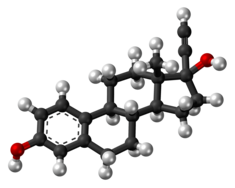 | |
 | |
| Clinical data | |
|---|---|
| Pronunciation | /ˌɛθɪnɪlˌɛstrəˈdaɪ.əl/ |
| Trade names | Many |
| Other names | Ethynylestradiol; Ethinyl estradiol; Ethinyl oestradiol; EE; EE2; 17α-Ethynylestradiol; 17α-Ethynylestra-1,3,5(10)-triene-3,17β-diol; NSC-10973[1] |
| AHFS/Drugs.com | International Drug Names |
| MedlinePlus | a604032 |
| Routes of administration | • By mouth, Transdermal, Vaginal |
| Drug class | Estrogen |
| ATC code | |
| Legal status | |
| Legal status |
|
| Pharmacokinetic data | |
| Bioavailability | 38–48%[2][3][4] |
| Protein binding | 97–98% (to albumin;[5] is not bound to SHBG)[6] |
| Metabolism | Liver (primarily CYP3A4)[9] |
| Metabolites | • Ethinylestradiol sulfate[7][8] • Others[7][8] |
| Elimination half-life | 7–36 hours[9][2][10][11] |
| Excretion | Feces: 62%[10] Urine: 38%[10] |
| Identifiers | |
| |
| CAS Number | |
| PubChem CID | |
| IUPHAR/BPS | |
| DrugBank | |
| ChemSpider | |
| UNII | |
| KEGG | |
| ChEBI | |
| ChEMBL | |
| CompTox Dashboard (EPA) | |
| ECHA InfoCard | 100.000.311 |
| Chemical and physical data | |
| Formula | C20H24O2 |
| Molar mass | 296.410 g·mol−1 |
| 3D model (JSmol) | |
| Melting point | 182 to 184 °C (360 to 363 °F) |
| |
| |
| (verify) | |
Ethinylestradiol (EE) is an estrogen medication which is used widely in birth control pills in combination with progestins.[7][8] In the past, EE was widely used for various indications such as the treatment of menopausal symptoms, gynecological disorders, and certain hormone-sensitive cancers. It is usually taken by mouth but is also used as a patch and vaginal ring.[7][12]
The general side effects of EE include breast tenderness and enlargement, headache, fluid retention, and nausea among others.[7] In men, EE can additionally cause breast development, feminization in general, hypogonadism, and sexual dysfunction. Rare but serious side effects include blood clots, liver damage, and cancer of the uterus.[7]
EE is an estrogen, or an agonist of the estrogen receptors, the biological target of estrogens like estradiol.[7] It is a synthetic derivative of estradiol, a natural estrogen, and differs from it in various ways.[7] Compared to estradiol, EE is more resistant to metabolism, has greatly improved bioavailability when taken by mouth, and shows relatively increased effects in certain parts of the body like the liver and uterus.[7] These differences make EE more favorable for use in birth control pills than estradiol, though also result in an increased risk of blood clots and certain other rare adverse effects.[7]
EE was developed in the 1930s and was introduced for medical use in 1943.[13][14] The medication started being used in birth control pills in the 1960s.[15] Ethinylestradiol is found in almost all combined forms of birth control pills and is nearly the exclusive estrogen used for this purpose, making it one of the most widely used estrogens.[16][17] The combination with norethisterone was already the 80th most commonly prescribed medication in the United States and the compound appears in many other common mediactions as well.;[18][19]
- ^ Cite error: The named reference
Elks2014was invoked but never defined (see the help page). - ^ a b Goldzieher JW, Brody SA (December 1990). "Pharmacokinetics of ethinyl estradiol and mestranol". American Journal of Obstetrics and Gynecology. 163 (6 Pt 2): 2114–2119. doi:10.1016/0002-9378(90)90550-Q. PMID 2256522.
- ^ Fruzzetti F, Trémollieres F, Bitzer J (May 2012). "An overview of the development of combined oral contraceptives containing estradiol: focus on estradiol valerate/dienogest". Gynecological Endocrinology. 28 (5): 400–408. doi:10.3109/09513590.2012.662547. PMC 3399636. PMID 22468839.
- ^ Fotherby K (August 1996). "Bioavailability of orally administered sex steroids used in oral contraception and hormone replacement therapy". Contraception. 54 (2): 59–69. doi:10.1016/0010-7824(96)00136-9. PMID 8842581.
- ^ Facts and Comparisons (Firm), Ovid Technologies, Inc (2005). Drug Facts and Comparisons 2005: Pocket Version. Facts and Comparisons. p. 121. ISBN 978-1-57439-179-4.
- ^ Micromedex (1 January 2003). USP DI 2003: Drug Information for Healthcare Professionals. Thomson Micromedex. pp. 1253, 1258, 1266. ISBN 978-1-56363-429-1.
- ^ a b c d e f g h i j Kuhl H (August 2005). "Pharmacology of estrogens and progestogens: influence of different routes of administration". Climacteric. 8 (Suppl 1): 3–63. doi:10.1080/13697130500148875. PMID 16112947. S2CID 24616324.
- ^ a b c Oettel M, Schillinger E (6 December 2012). Estrogens and Antiestrogens II: Pharmacology and Clinical Application of Estrogens and Antiestrogen. Springer Science & Business Media. pp. 4, 10, 15, 165, 247–248, 276–291, 363–408, 424, 514, 540, 543, 581. ISBN 978-3-642-60107-1.
The binding affinity of EE2 for the estrogen receptor is similar to that of estradiol. [...] During daily intake, the EE2 levels increase up to a steady state which is reached after about 1 week.
- ^ a b Hughes CL, Waters MD (23 March 2016). Translational Toxicology: Defining a New Therapeutic Discipline. Humana Press. pp. 73–. ISBN 978-3-319-27449-2.
- ^ a b c Cite error: The named reference
pmid23375353was invoked but never defined (see the help page). - ^ Cite error: The named reference
Shellenberger1986was invoked but never defined (see the help page). - ^ Cite error: The named reference
Drugs@FDAwas invoked but never defined (see the help page). - ^ Fischer J, Ganellin CR (2006). Analogue-based Drug Discovery. John Wiley & Sons. p. 482. ISBN 978-3-527-60749-5.
- ^ Cite error: The named reference
Estinyl 1943was invoked but never defined (see the help page). - ^ Cite error: The named reference
GruhnKazer2013was invoked but never defined (see the help page). - ^ Evans G, Sutton EL (May 2015). "Oral contraception". The Medical Clinics of North America. 99 (3): 479–503. doi:10.1016/j.mcna.2015.01.004. PMID 25841596.
- ^ Shoupe D, Haseltine FP (6 December 2012). Contraception. Springer Science & Business Media. pp. 112–. ISBN 978-1-4612-2730-4.
- ^ "The Top 300 of 2022". ClinCalc. Archived from the original on 30 August 2024. Retrieved 30 August 2024.
- ^ "Ethinyl Estradiol; Norethindrone Drug Usage Statistics, United States, 2013 - 2022". ClinCalc. Retrieved 30 August 2024.